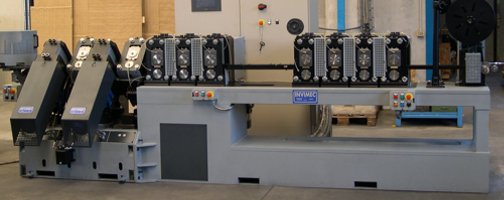The production of specific products for industry and jewelry sectors has been always done with different technologies and machines to process metal.
Doors and windows for building, metal carpentry and public transport, plate for automotive sector, furniture for office or house, semi-finished products for watchmaking and jewelry industry: these products are often united by forming metal processes.
Cold forming is a modern system for metal profile that combines different processes in a single course, in order to obtain tubes with or without welding, open or closed tubes, hollow or filled, tubes with specific shape and profile.
But, in particular, what is the process of cold forming and what happens inside a forming machine?
Cold rolling forming process and forming machine
The cold forming process, or cold rolling forming process, is an industrial procedure for metal plates and strips (usually in steel), that are shaped in a continuous process until the desired tube or profile is achieved.
The plate passes between a series of rolls that bend the material in order to obtain the section wanted. Compared to the extrusion machines, rolling forming machines are able to process profile lighter, thinner and tougher thanks to the cold rolling, which is also faster and with a significant energy saving.
Forming machines are ideal for long tube and profile production, with high volume and constant shape: cold profiles are used in various industrial areas, like construction, automotive, shipbuilding, electronic and machines production, but also in jewelry and watchmaking sectors.
How forming machines works
Usually a forming machine is comprised of coiler, a profiling system and a cutting line:
– Coiler: is used to continuously insert the material in the forming machine, in particular for massive production;
– Forming machine: comprised of upper and lower rolls, in order to forming the required profile (different profiles usually require different rolls)
– Cutting line: is used to cut the plate in a specific point, before the forming line..
The metal is cold folded thanks to a line of forming rolls that process the profile required: the forming heads ensure a constant metal bending, keeping the correct cross-section.
In addition to forming, usually the cold forming machines are able to do others metal processes, like welding, that is carried out using the most advanced technologies according to the metal used.
How to choose a forming machine
In the designing and choosing phase, is necessary to evaluate the main features of forming machine, based on model, function and aim of production:
- The product to make and the metal material to process: from gold, silver and platinum for the jewelry sector, to brass, bronze, copper, afnio or zirconium.
- The thickness of plate, tube or profile, which can be from only a few tenths of a millimetre (usually 0,2 mm) until 2mm;
- The section wanted: mainly round, or more rarely special profiles, like oval or rectangular; for others applications open profiles or overlapped tubes are needed
- The number of passages: reaching the fewest passages possible, is useful in order to simplify the process and optimize the production;
- Additional features like the solid core in the tube, the TIG or laser welding, the insertion of a powder core during the process, etc.
In order to find the best suited forming machine, it is often necessary to have a focused design of the rolling machine, for the special production needs of the customer. This is why INVIMEC offers its know-how to design and manufacture rolling forming machines and tube forming machines, adaptable to any need of the final client.
Contact us and find out how INVIMEC can satisfy your every enquiry regarding rolling systems and forming systems, and in general regarding the metal cold process.
